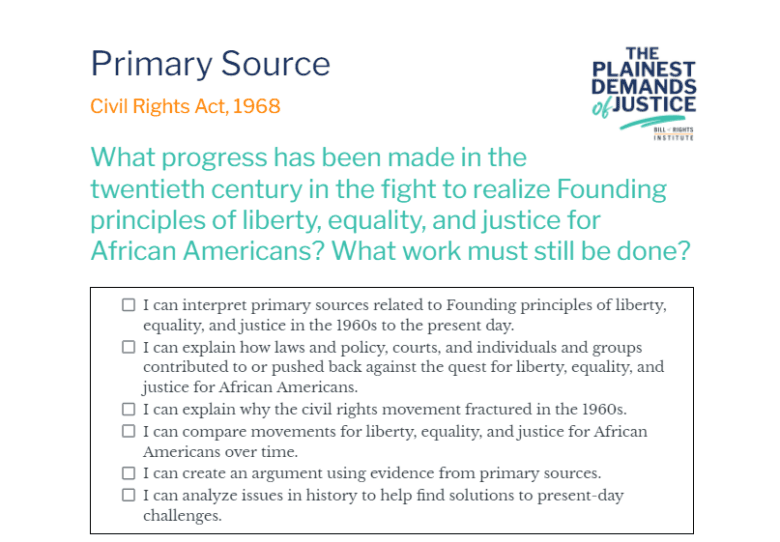Civil Rights Act, 1968
What progress has been made in the twentieth century in the fight to realize Founding principles of liberty, equality, and justice for African Americans? What work must still be done?
- I can interpret primary sources related to Founding principles of liberty, equality, and justice in the 1960s to the present day.
- I can explain how laws and policy, courts, and individuals and groups contributed to or pushed back against the quest for liberty, equality, and justice for African Americans.
- I can explain why the civil rights movement fractured in the 1960s.
- I can compare movements for liberty, equality, and justice for African Americans over time.
- I can create an argument using evidence from primary sources.
- I can analyze issues in history to help find solutions to present-day challenges.
Building Context
The Civil Rights Act of 1968, or the Fair Housing Act as it is commonly known, passed the House of Representatives in 1966, only to die in the Senate. President Lyndon B. Johnson pushed for its passage in 1967, but again the bill appeared to be stuck. After the assassination of Martin Luther King, Jr., and the ensuing violence that broke out in cities across the country, the president once more urged Congress to pass the bill. Debate was heated, but the bill ultimately passed. President Johnson signed it into law on April 11, 1968, two days after the funeral of Martin Luther King, Jr.
Civil Rights Act, 1968
Source: https://www.govinfo.gov/content/pkg/COMPS-343/pdf/COMPS-343.pdf
SEC. 804. . . . .it shall be unlawful—(a) To refuse to sell or rent after the making of a bona fide offer, or to refuse to negotiate for the sale or rental of, or otherwise make unavailable or deny, a dwelling to any person because of race, color, religion, sex, familial status, or national origin. (b) To discriminate against any person in the terms, conditions, or privileges of sale or rental of a dwelling, or in the provision of services or facilities in connection therewith, because of race, color, religion, sex, familial status, or national origin. (c) To make, print, or publish, or cause to be made, printed, or published any notice, statement, or advertisement, with respect to the sale or rental of a dwelling that indicates any preference, limitation, or discrimination based on race, color, religion, sex, handicap, familial status, or national origin, or an intention to make any such preference, limitation, or discrimination. (d) To represent to any person because of race, color, religion, sex, handicap, familial status, or national origin that any dwelling is not available for inspection, sale, or rental when such dwelling is in fact so available.
Comprehension and Analysis Questions
- What effect did this act have on the policies of redlining and racial restrictive covenants?
- In your own words, summarize the purpose of this act.
